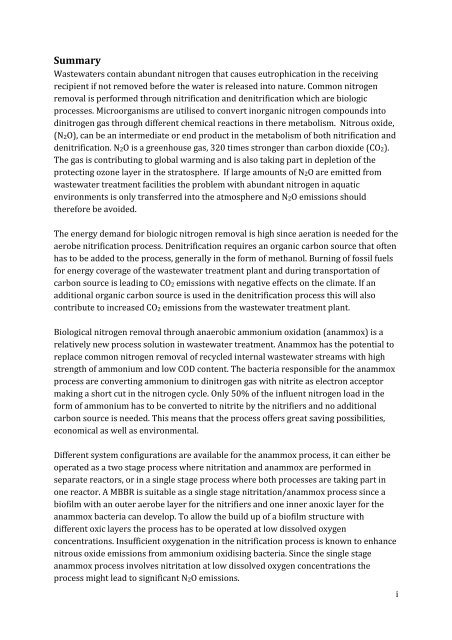N2O production in a single stage nitritation/anammox MBBR process
N2O production in a single stage nitritation/anammox MBBR process
N2O production in a single stage nitritation/anammox MBBR process
You also want an ePaper? Increase the reach of your titles
YUMPU automatically turns print PDFs into web optimized ePapers that Google loves.
Summary<br />
Wastewaters conta<strong>in</strong> abundant nitrogen that causes eutrophication <strong>in</strong> the receiv<strong>in</strong>g<br />
recipient if not removed before the water is released <strong>in</strong>to nature. Common nitrogen<br />
removal is performed through nitrification and denitrification which are biologic<br />
<strong>process</strong>es. Microorganisms are utilised to convert <strong>in</strong>organic nitrogen compounds <strong>in</strong>to<br />
d<strong>in</strong>itrogen gas through different chemical reactions <strong>in</strong> there metabolism. Nitrous oxide,<br />
(<strong>N2O</strong>), can be an <strong>in</strong>termediate or end product <strong>in</strong> the metabolism of both nitrification and<br />
denitrification. <strong>N2O</strong> is a greenhouse gas, 320 times stronger than carbon dioxide (CO2).<br />
The gas is contribut<strong>in</strong>g to global warm<strong>in</strong>g and is also tak<strong>in</strong>g part <strong>in</strong> depletion of the<br />
protect<strong>in</strong>g ozone layer <strong>in</strong> the stratosphere. If large amounts of <strong>N2O</strong> are emitted from<br />
wastewater treatment facilities the problem with abundant nitrogen <strong>in</strong> aquatic<br />
environments is only transferred <strong>in</strong>to the atmosphere and <strong>N2O</strong> emissions should<br />
therefore be avoided.<br />
The energy demand for biologic nitrogen removal is high s<strong>in</strong>ce aeration is needed for the<br />
aerobe nitrification <strong>process</strong>. Denitrification requires an organic carbon source that often<br />
has to be added to the <strong>process</strong>, generally <strong>in</strong> the form of methanol. Burn<strong>in</strong>g of fossil fuels<br />
for energy coverage of the wastewater treatment plant and dur<strong>in</strong>g transportation of<br />
carbon source is lead<strong>in</strong>g to CO2 emissions with negative effects on the climate. If an<br />
additional organic carbon source is used <strong>in</strong> the denitrification <strong>process</strong> this will also<br />
contribute to <strong>in</strong>creased CO2 emissions from the wastewater treatment plant.<br />
Biological nitrogen removal through anaerobic ammonium oxidation (<strong>anammox</strong>) is a<br />
relatively new <strong>process</strong> solution <strong>in</strong> wastewater treatment. Anammox has the potential to<br />
replace common nitrogen removal of recycled <strong>in</strong>ternal wastewater streams with high<br />
strength of ammonium and low COD content. The bacteria responsible for the <strong>anammox</strong><br />
<strong>process</strong> are convert<strong>in</strong>g ammonium to d<strong>in</strong>itrogen gas with nitrite as electron acceptor<br />
mak<strong>in</strong>g a short cut <strong>in</strong> the nitrogen cycle. Only 50% of the <strong>in</strong>fluent nitrogen load <strong>in</strong> the<br />
form of ammonium has to be converted to nitrite by the nitrifiers and no additional<br />
carbon source is needed. This means that the <strong>process</strong> offers great sav<strong>in</strong>g possibilities,<br />
economical as well as environmental.<br />
Different system configurations are available for the <strong>anammox</strong> <strong>process</strong>, it can either be<br />
operated as a two <strong>stage</strong> <strong>process</strong> where <strong>nitritation</strong> and <strong>anammox</strong> are performed <strong>in</strong><br />
separate reactors, or <strong>in</strong> a s<strong>in</strong>gle <strong>stage</strong> <strong>process</strong> where both <strong>process</strong>es are tak<strong>in</strong>g part <strong>in</strong><br />
one reactor. A <strong>MBBR</strong> is suitable as a s<strong>in</strong>gle <strong>stage</strong> <strong>nitritation</strong>/<strong>anammox</strong> <strong>process</strong> s<strong>in</strong>ce a<br />
biofilm with an outer aerobe layer for the nitrifiers and one <strong>in</strong>ner anoxic layer for the<br />
<strong>anammox</strong> bacteria can develop. To allow the build up of a biofilm structure with<br />
different oxic layers the <strong>process</strong> has to be operated at low dissolved oxygen<br />
concentrations. Insufficient oxygenation <strong>in</strong> the nitrification <strong>process</strong> is known to enhance<br />
nitrous oxide emissions from ammonium oxidis<strong>in</strong>g bacteria. S<strong>in</strong>ce the s<strong>in</strong>gle <strong>stage</strong><br />
<strong>anammox</strong> <strong>process</strong> <strong>in</strong>volves <strong>nitritation</strong> at low dissolved oxygen concentrations the<br />
<strong>process</strong> might lead to significant <strong>N2O</strong> emissions.<br />
i















